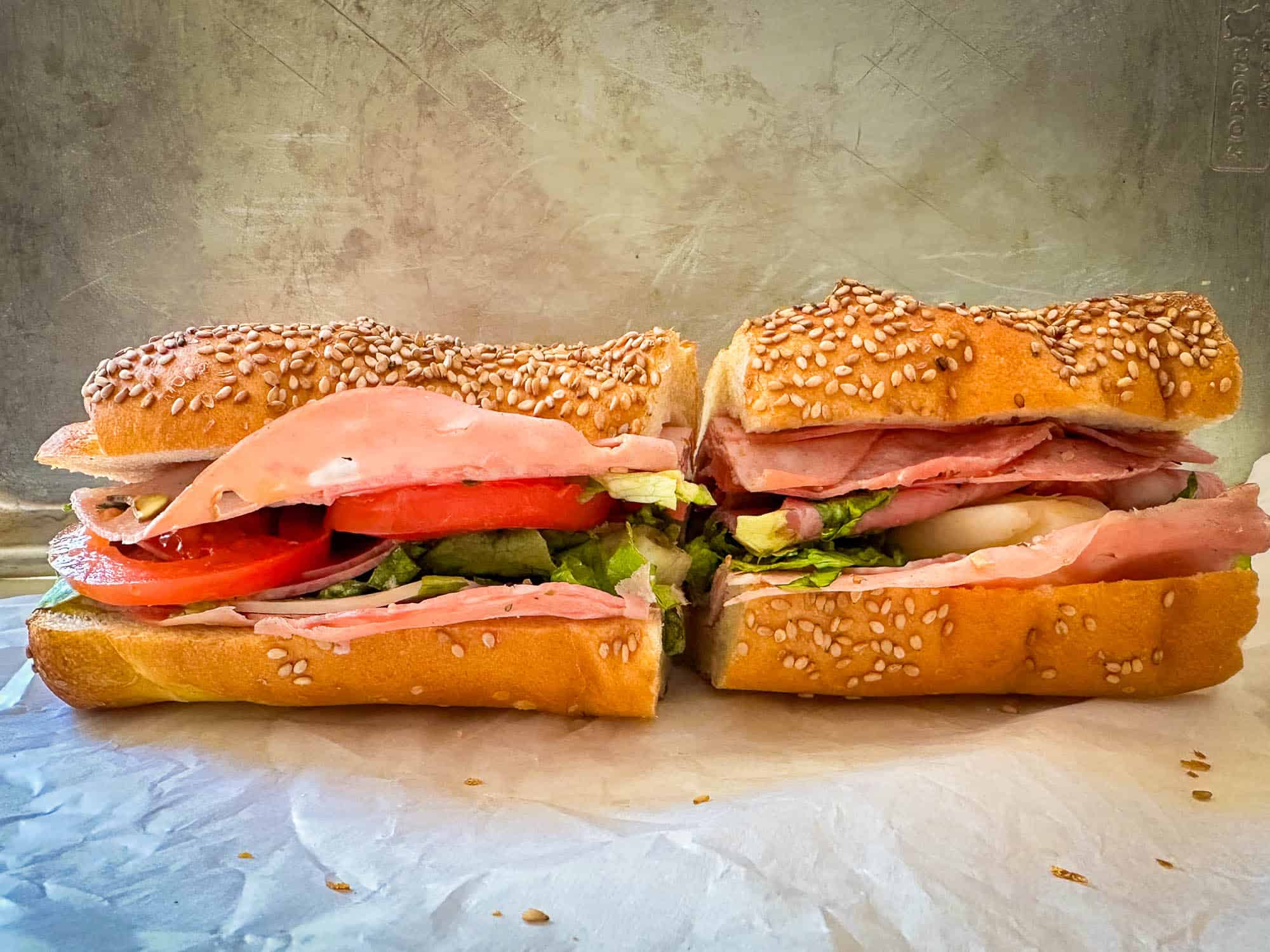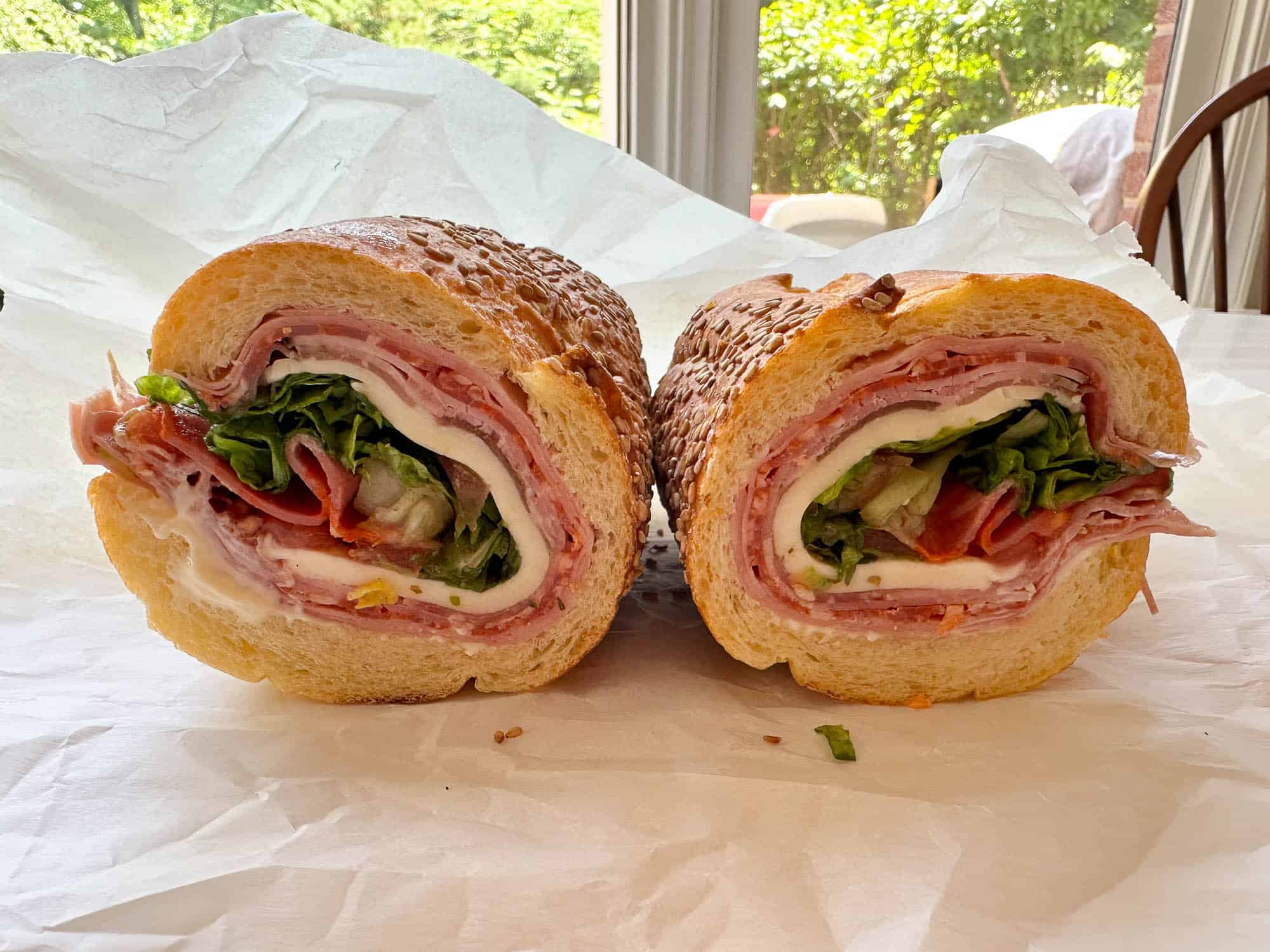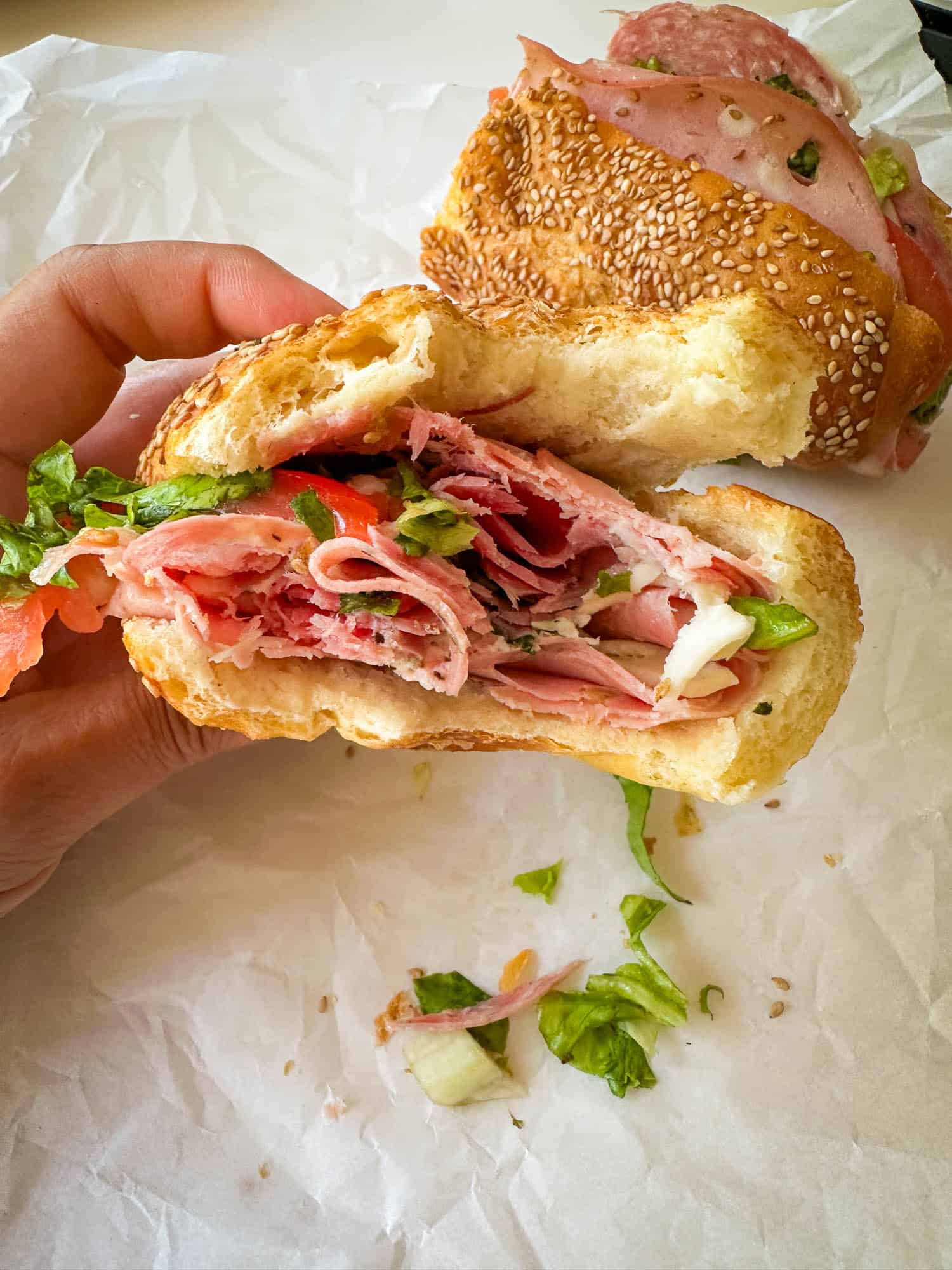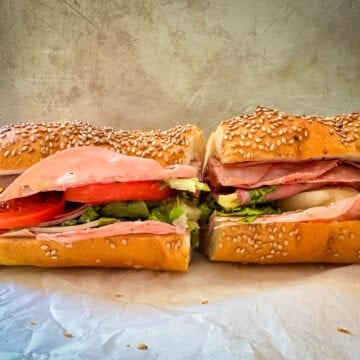This post may contain affiliate links. For more information, please see our disclosure policy.
A hoagie is Philly’s version of a sub—an Italian-American sandwich stacked with meats, cheese, and crisp veggies on a long roll. Born in South Philly’s Italian neighborhoods (some report Delco – a suburb of Philly), this sandwich has been perfected over decades by people who know what they’re doing.
Philadelphia’s best Italian hoagie is always a subject of debate – I’d say it often depends on the bread and how stuffed it is. I don’t love an overstuffed sandwich, but to each his own, as they say!

How to Build a Classic Italian Hoagie
It starts with the roll—that’s nonnegotiable. You want a proper hoagie roll (usually about 8 to 12 inches long) with a crisp crust and chewy inside. Seeded rolls give you more crunch; unseeded are softer. The bread is never sliced all the way through—it’s always left hinged.
Among the many hoagie variations, the Italian hoagie is the gold standard. Thin-sliced Italian cold cuts—usually freshly sliced hot or mild capicola, Genoa salami, cotechino (or was this meant to be capicola again?), mortadella, or prosciutto—layered with mild or sharp provolone cheese. (Provolone is the default, but you can request other cheeses like Cooper Sharp or American.) The meat and cheese is topped with shredded iceberg lettuce, thin tomato slices, and paper-thin onions (and everything’s customizable). Take a look at one of the best pizza and hoagie shops in South Philly—Angelo’s menu—for an example of a traditional Italian hoagie.
The finishing touch is simple: olive oil, oregano, salt, and pepper, applied on top of the vegetables. That’s the proper order—meats and cheese first, then vegetables, then the oil and seasonings on top. Nobody wants oil soaking into the bread. Can you add mayo? Sure—it’s not traditional, but these sandwiches are customizable. And if you’re from NY, you might want vinegar too, but that’s not a classic hoagie dressing either.
Most places scoop out some of the bread’s interior to make room for the fillings. When it’s done right, every bite has that perfect balance of salty meat, sharp cheese, and crisp vegetables—all held together by bread that can handle the job.
Watch How It’s Made
Italian Hoagie vs. Sub?
It’s the small differences that distinguish a Philadelphia Italian hoagie from its cousin, the Italian sub—even though they can be very similar.
To sum it up: the classic Italian hoagie (not customized) is made on a long Italian hoagie roll or a piece of seeded Italian bread, left hinged when cut, and typically filled with specific Italian cold cuts, mild or sharp provolone, shredded iceberg lettuce, sliced tomatoes, onions, and simply dressed with oil, salt, pepper, and oregano. That combo sets it apart from other subs.
Some rebels may opt for mayo (you know who you are) or a splash of vinegar, but most classic Italian hoagies don’t contain this by default.
It’s All About the Bread (IYKYK)!
You can’t have a great hoagie without great bread, and Philly’s bakeries know how to deliver. The city’s hoagie roll tradition runs deep, thanks to family-owned bakeries that have been perfecting their craft for generations. Some local groceries, delis, or produce markets carry bread from the following bakeries:
- Sarcone’s Bakery (est. 1918) on South 9th Street is a South Philly institution known for its brick oven rolls.
- Carangi Baking Company (since 1996) on South Iseminger Street supplies some of the city’s best hoagie shops.
- Cacia’s Bakery, in business since 1953, operates in South Philly and several New Jersey locations.
- Conshohocken Italian Bakery is famous for their 11–12 inch rolls that hold up to serious fillings.
- Liscio’s Bakery in Glassboro, NJ, makes soft, chewy 9–11 inch rolls beloved by sandwich shops.
- Amoroso’s (founded in 1904) and Aversa’s round out the list, each with a loyal following.
Did I leave any off the list? Let me know! Locals will argue about who bakes the best roll, but one thing’s for sure: the bread makes the hoagie. Not in Philly? Try making your own hoagie rolls!

Italian Meats: the Heart of the Hoagie
Italian lunch meats showcase Italy’s diverse charcuterie traditions. Together in sandwiches like hoagies, a mixture of meats create a perfect blend of Italy’s savory heritage. Here are some typical meats found in an Italian hoagie (usually 3 to 4 are mixed together):
- Mortadella: A classic Italian cold cut with a slightly sweet and savory flavor, often studded with pistachios.
- Imported Ham: High-quality imported ham, such as Prosciutto di Parma or Prosciutto San Daniele, adds an authentic Italian touch with its rich flavor and silky texture. Prosciutto should be Parma or San Danielle in my humble opinion, some brands are all salt and no flavor. The Mediterranean air is key to producing a good proscuitto!
- Coppa (Capocollo/Capicola/Capi): Dry-cured Italian cold cut with a rich and robust flavor, featuring a balance of lean and fatty parts.
- Genoa Salami: Coarsely ground Italian salami seasoned with garlic and red wine, offering a bold and slightly spicy taste.
- Soppressata: Spicy and tangy Italian dry-cured salami available in varying levels of spiciness, adding zesty flavor.

Top Tips
- Use fresh, high-quality ingredients for the best flavor.
- Bread is the foundation—get fresh rolls from a local bakery.
- Choose premium Italian meats and cheeses, sliced thin.
- Layer cheese between meats and veggies to reduce sogginess.
- Dress the veggies, not the bread, to prevent sogginess.
- Customize ingredients and seasonings to your taste.
- Enjoy immediately for best texture and flavor.
♥️ Loved this recipe? I’d be thrilled if you’d rate it ⭐️ and share your experience in the comments below! Your ratings and comments help other readers discover this recipe and keep this blog going. Did you add any special tweaks? Our community of home cooks would love to hear about it! ♥️
📖 Recipe

The Italian Hoagie
A hoagie is a classic Philly sandwich piled high with Italian meats, sharp or mild provolone cheese, and crisp veggies (lettuce, tomato, onion) on a chewy Italian roll—simple, satisfying, and worth making at home!
Meats and Cheeses (see Note)
For the Toppings and Seasoning
Prevent your screen from going dark
Prepare the Bread:
Slice the hoagie rolls lengthwise, leaving a hinge on one side. If you'd like, scoop out a bit of the crumb to create more room for the toppings.
Assemble the Hoagies:
Layer the meats (e.g., Genoa salami, capicola, and mortadella, etc) evenly on the bottom half of the rolls.
Add the provolone cheese slices on top of the meats.
Add the Vegetables:
Add tomato slices, followed by lettuce and onions, covering the meats and cheese completely.
Drizzle the olive oil over the vegetables, then sprinkle a pinch of dried oregano, and add salt (optional) and black pepper on top. You may also add some hot or sweet peppers (jarred pickled).
Finish and Serve:
Carefully close the hoagie by pressing the top half onto the vegetables.
Optionally, you can wrap the hoagies in parchment paper or plastic wrap to hold them together and make them easier to eat.
Calories: 1027kcalCarbohydrates: 42gProtein: 57gFat: 72gSaturated Fat: 28gPolyunsaturated Fat: 7gMonounsaturated Fat: 31gCholesterol: 166mgSodium: 3896mgPotassium: 645mgFiber: 3gSugar: 8gVitamin A: 1353IUVitamin C: 14mgCalcium: 472mgIron: 14mg
❓ Frequently Asked Questions
What is a Philadelphia hoagie?
A long Italian roll filled with cold cuts, cheese, lettuce, tomato, onion, and seasoned with oil, salt, pepper, and oregano. It’s distinct from other subs thanks to its ingredients and prep style.
What kind of bread should I use?
Use a genuine Italian hoagie roll—8–12 inches long, crusty outside, soft inside.
What meats and cheeses are traditionally used in an Italian hoagie?
- Capocollo, salami, Soppressata, imported ham, mortadella, and provolone or American cheese
How do I prepare the vegetables?
- Lettuce: Thinly shredded iceberg
- Tomatoes: Sliced about 1/4 inch thick
- Onions: Paper-thin white or yellow
- Hot peppers (optional): Cherry or banana peppers or long hots
What’s the proper dressing?
Extra virgin olive oil, salt, pepper, and dried oregano. No vinegar in the classic version.
How do I assemble the hoagie?
- Slice roll lengthwise, leaving it hinged
- Layer meats and cheese
- Add lettuce, tomato, onion
- Drizzle oil and seasonings on top of the veggies
- Close and wrap tightly
Should I toast the bread?
Nope. Philly hoagies use untoasted bread. Toasted versions are called grinders.
How much filling should I use?
Use about 4–6 oz of meat and 2–3 oz of cheese per sandwich. Don’t overstuff.
Can I make it ahead?
A few hours ahead is fine, but wait to add tomatoes and dressing until right before serving. Wrap tightly in paper or foil.
What makes it different from other subs?
Philly Italian hoagies stand out for their hinged roll, specific cold cuts, shredded lettuce, and oil/oregano dressing.
Source link
